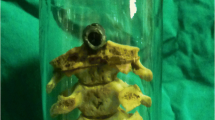Abstract
Contact gunshot wounds are usually characterized by a muzzle imprint, a powder cavity (“pocket”), the presence of carboxyhemoglobin and often also stellate tears of the skin radiating from the bullet entrance hole. In shots to the cerebral cranium an additional sign may be observed around the bone defect: the periosteum is detached and reflected with soot on the underside. The frequency and possible causes of these periosteal findings are discussed on the basis of 68 contact gunshot wounds from forensic autopsy material and experimental shots fired against the frontal bone of a slaughtered calf.



Similar content being viewed by others
References
Berg S, Kijewski H (1982) Vermeintliche und wirkliche Nahschusszeichen am Knocheneinschussloch des Schädels. Z Rechtsmed 88:103–111
Dana SE, Di Maio VJM (2003) Gunshot trauma. In: Payne-James J, Busuttil A, Smock W (eds) Forensic medicine: clinical and pathological aspects. Greenwich Medical Media, London, pp 149–168
Di Maio VJM (1999) Gunshot wounds, 2nd edn. CRC Press, Boca Raton, pp 125–134, 383–388
Faller-Marquardt M, Pollak S (2000) Gemeinschaftlicher Suizid mit Schussabgabe in die Scheitelregion. Rechtsmedizin 10:148–152
Faller-Marquardt M, Pollak S (2002) Skin tears away from the entrance wound in gunshots to the head. Int J Legal Med 116:262–266
Fritz E (1933) Randabsprengungen an der Einschussseite des Schädelknochens bei Nahschüssen aus mehrschüssigen Faustfeuerwaffen. Dtsch Z Ges Gerichtl Med 20:598–607
Große Perdekamp M, Braunwarth R, Schmidt U, Schmidt W, Pollak S (2003) Zum absoluten Nahschuss aus Infanteriewaffen mit Mündungsstück. Arch Kriminol 212:10–18
Große Perdekamp M, Schmidt U, Rupp W, Braunwarth R, Rost T, Pollak S (2004) Contact shot with unusual soot pattern. Forensic Sci Int (in press)
Haberda A (1893) Atypische Lage der Einschussöffnung beim Selbstmord durch Schuss in den Kopf. Vierteljahresschr Gerichtl Med 5:221–229
Karger B (2003) Schussverletzungen. In: Brinkmann B, Madea B (eds) Handbuch gerichtliche Medizin. Springer, Berlin Heidelberg New York, pp 593–682
Karger B, Teige K (1998) Fatalities from black powder percussion handguns. Forensic Sci Int 98:143–149
Marty W, Sigrist T, Wyler D (2002) Determination of firing distance using the rhodizonate staining technique. Int J Legal Med 116:1–4
Pollak S (1982) Zur Makro- und Mikromorphologie der durch Faustfeuerwaffen erzeugten Einschusswunden. Beitr Gerichtl Med 40:493–520
Pollak S (2004) Fehler und Irrtümer bei der ärztlichen Beurteilung von Schussverletzungen. In: Medigovic U, Graft C (eds) Festschrift für Manfred Burgstaller. Neuer Wissenschaftlicher Verlag, Wien pp 619–633
Pollak S, Ritt F (1992) Vergleichende Untersuchungen an Einschusslücken in Rumpf- und Extremitätenknochen mit vorwiegend spongiöser Struktur. Beitr Gerichtl Med 50:363–372
Pollak S, Rothschild MA (2004) Gunshot injuries as a topic of medicolegal research in the German-speaking countries from the beginning of the 20th century up to the present time. Forensic Sci Int 144:201–210
Pollak S, Saukko P (2003) Atlas of forensic medicine (CD-ROM). Elsevier, Amsterdam, Fig. 7.1.009, 7.1.018
Rothschild MA (1999) Freiverkäufliche Schreckschusswaffen. Medizinische, rechtliche und kriminaltechnische Bewertung. Schmidt-Römhild, Lübeck, pp 79–84
Sellier K (1982) Schusswaffen und Schusswirkungen I. Ballistik, Medizin und Kriminalistik. Schmidt-Römhild, Lübeck, pp 150–152, 207–237
Sellier K (1988) Schussentfernungsbestimmung, 2nd edn. Schmidt-Römhild, Lübeck, pp 35–41
Sigrist T (1984) Über die Entstehung der Oberhautverletzung am Einschuss beim Schuss mit aufgesetzter Waffe. Z Rechtsmed 93:199–210
Spitz WU (1993) Gunshot wounds. In: Spitz WU (ed) Medicolegal investigation of death, 3rd edn. Charles C. Thomas, Springfield, pp 316–320
Stein KM, Bahner ML, Merkel J, Ain S, Mattern R (2000) Detection of gunshot residues in routine CTs. Int J Legal Med 114:15–18
Thali MJ, Kneubuehl BP, Dirnhofer R, Zollinger U (2002) The dynamic development of the muzzle imprint by contact gunshot: high-speed documentation utilizing the “skin-skull-brain model”. Forensic Sci Int 127:168–173
Verhoff MA, Karger B (2003) Atypical gunshot entrance wound and extensive backspatter. Int J Legal Med 117:229–231
Author information
Authors and Affiliations
Corresponding author
Additional information
Dedicated to Prof. Dr. Dr. h.c. B. Brinkmann on the occasion of his 65th birthday.
Rights and permissions
About this article
Cite this article
Faller-Marquardt, M., Bohnert, M. & Pollak, S. Detachment of the periosteum and soot staining of its underside in contact shots to the cerebral cranium. Int J Legal Med 118, 343–347 (2004). https://doi.org/10.1007/s00414-004-0486-8
Received:
Accepted:
Published:
Issue Date:
DOI: https://doi.org/10.1007/s00414-004-0486-8




